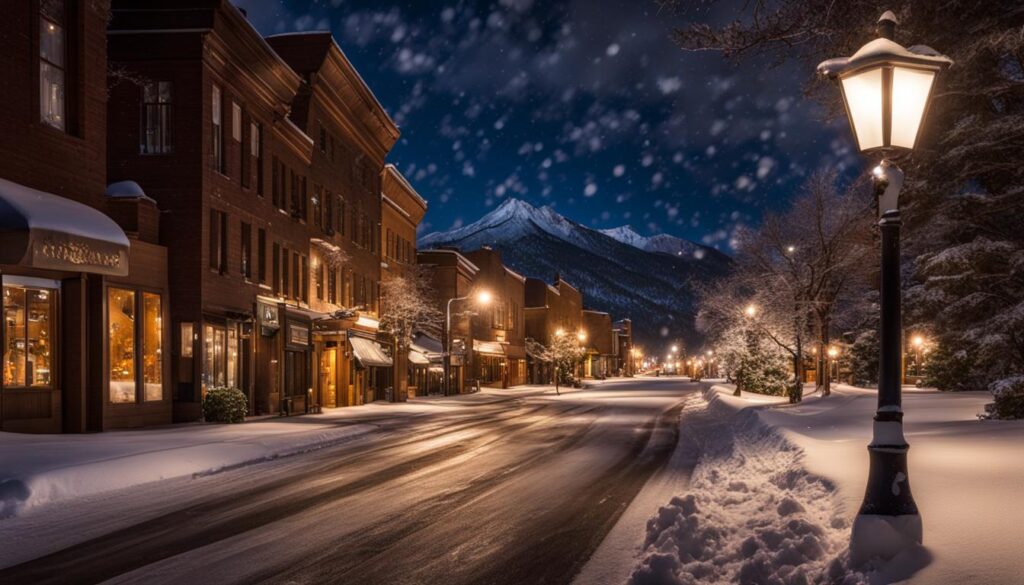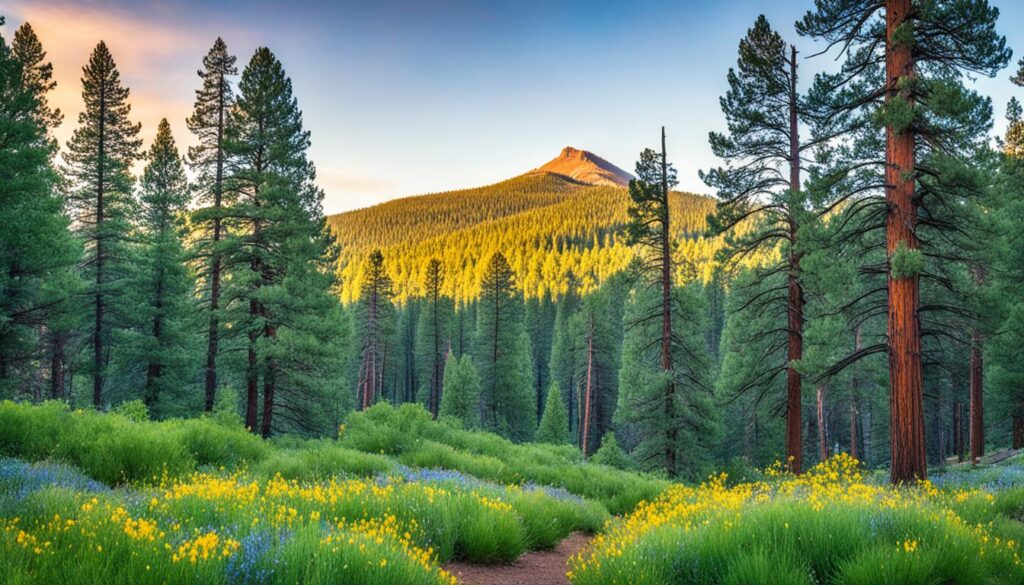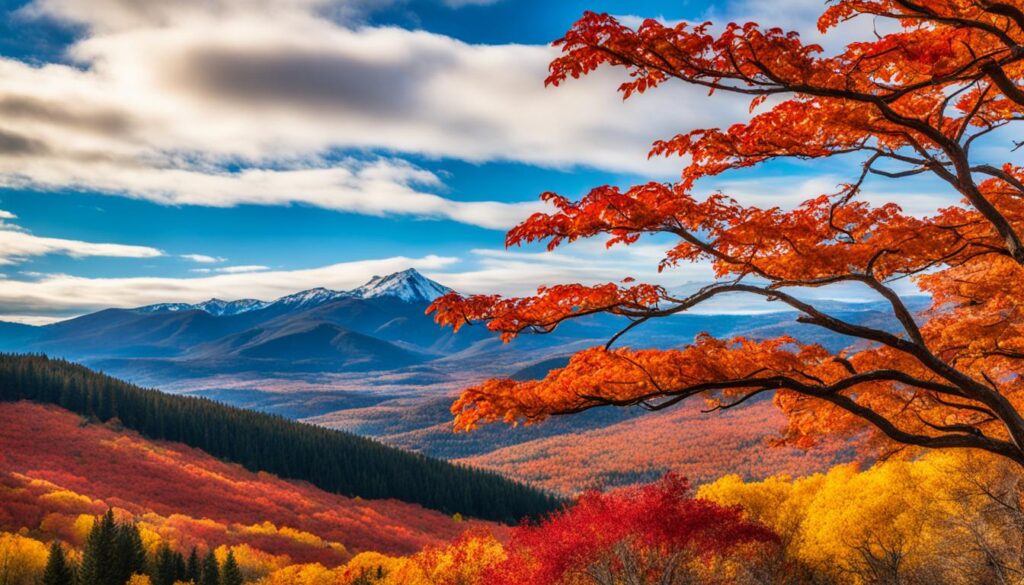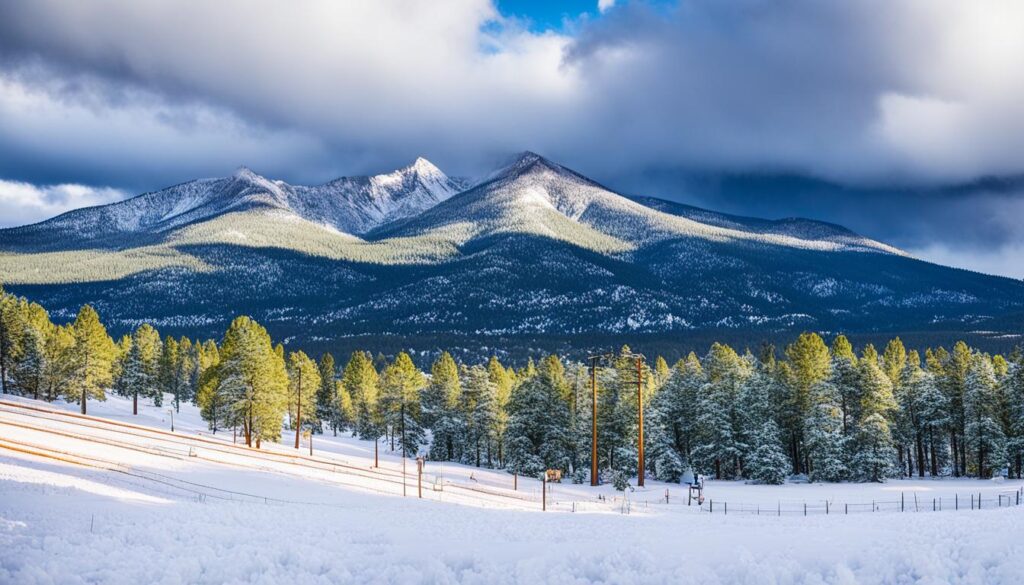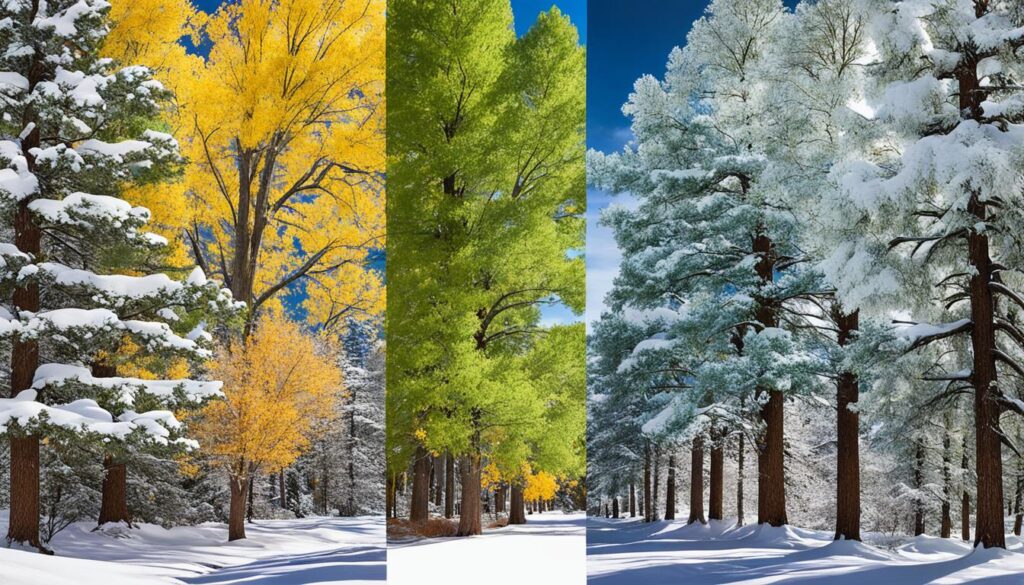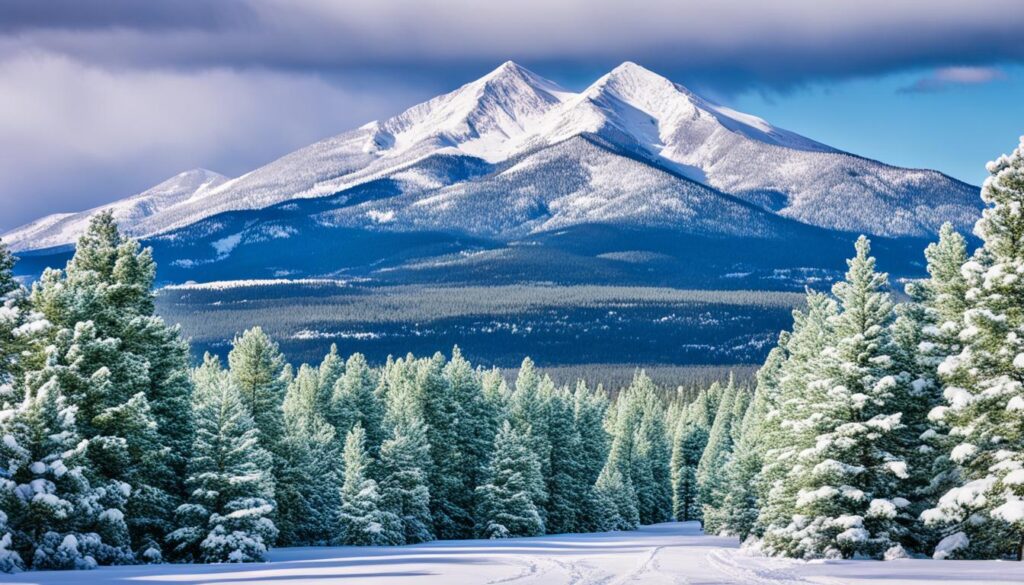Are you curious about the weather patterns in Flagstaff? Do you want to know more about the climate overview of this enchanting city? Look no further, as we present to you the ultimate Flagstaff Weather Guide, revealing everything you need to know about the annual weather in this picturesque location.
From the stunning snowy winters to the vibrant fall foliage, Flagstaff boasts a diverse range of seasons that leave both locals and visitors in awe. But what exactly are the Flagstaff weather patterns that define each season? How does the city’s climate overview attract nature enthusiasts and outdoor adventurers?
Join us on this picturesque journey through the seasons as we unravel the mysteries behind Flagstaff’s weather. From understanding the different seasons and their unique characteristics to exploring extreme weather events and long-term climate trends, we will dive deep into the fascinating world of Flagstaff’s annual weather.
So, pack your bags, bring your curiosity, and let’s embark on a captivating meteorological exploration of Flagstaff’s beautiful seasons. Get ready to be amazed!
Understanding Flagstaff’s Seasons
Flagstaff, Arizona experiences distinct seasons throughout the year, each characterized by unique weather conditions and climate trends. By understanding these seasonal variations, you can better plan your activities and make the most of your time in this beautiful city.
Let’s take a closer look at the different seasons in Flagstaff and the annual weather conditions you can expect:
Spring
Spring in Flagstaff is a time of transition and renewal. The average temperatures start to rise, ranging from the 50s to the 70s Fahrenheit (10-20 degrees Celsius). The city experiences mild rainfall during this season, with occasional snow showers in the higher elevations. Springtime is also characterized by the blooming of colorful wildflowers, creating a picturesque landscape.
Summer
Summers in Flagstaff are warm and pleasant, with average temperatures ranging from the 70s to the low 80s Fahrenheit (20-28 degrees Celsius). However, the evenings can be cool due to the city’s high elevation. Flagstaff experiences a unique weather phenomenon known as the monsoon season during the summer months. This monsoon brings intense thunderstorms and heavy rainfall, which helps alleviate the dryness of the region. It’s important to note that these storms can also result in flash floods, so caution is advised.
Fall
Fall is a breathtaking season in Flagstaff, as the foliage transforms into vibrant shades of red, orange, and yellow. The average temperatures during the fall season range from the 50s to the 70s Fahrenheit (10-20 degrees Celsius). As the season progresses, the temperatures gradually drop, especially in the evenings. Fall in Flagstaff is generally dry, with clear skies and crisp air, making it a perfect time for outdoor activities and enjoying the scenic beauty.
Winter
Winter in Flagstaff brings cold temperatures and abundant snowfall, making it a popular destination for winter sports enthusiasts. The average winter temperatures range from the 20s to the 40s Fahrenheit (-7 to 4 degrees Celsius). The city receives an average of 100 inches (254 centimeters) of snow annually, creating a winter wonderland for skiing, snowboarding, and other snow-related activities. It’s important to dress warmly and be prepared for icy conditions during this time of year.
| Season | Average Temperature | Precipitation |
|---|---|---|
| Spring | 50s to 70s°F (10-20°C) | Mild rainfall, occasional snow showers |
| Summer | 70s to low 80s°F (20-28°C) | Monsoon season with thunderstorms and heavy rainfall |
| Fall | 50s to 70s°F (10-20°C) | Dry with clear skies |
| Winter | 20s to 40s°F (-7 to 4°C) | Abundant snowfall |
Understanding the annual weather conditions and seasonal climate trends in Flagstaff is essential for planning your visit. Whether you’re looking to enjoy outdoor adventures in the summer or experience winter sports in the snowy months, Flagstaff offers something for everyone throughout the year.
Winter Weather in Flagstaff
When it comes to winter weather, Flagstaff experiences a unique climate that attracts visitors from across the country. The average temperature variations throughout the winter months create a picturesque winter wonderland that is perfect for outdoor activities and winter sports.
Flagstaff’s yearly weather report reveals that the winter season brings colder temperatures and significant snowfall. During the months of December, January, and February, the average temperatures range from 26°F to 46°F, creating a chilly but invigorating atmosphere. However, it is important to note that temperatures can sometimes drop below freezing, so it’s essential to bundle up and stay warm.
The snowfall in Flagstaff during winter is nothing short of impressive. The city is known for its abundant snowfall, making it a sought-after destination for snow enthusiasts. On average, Flagstaff receives around 100 inches of snow each winter, transforming the landscape into a pristine white blanket. This fresh snowfall offers excellent opportunities for skiing, snowboarding, and other winter activities in the nearby Snowbowl Ski Resort.
With the snowy conditions, it’s crucial to be prepared for winter-related conditions. Make sure to equip your vehicle with snow tires or chains if necessary, and allow extra time for travel to ensure a safe and enjoyable winter experience in Flagstaff.
“Winter is the season where Flagstaff truly shines. The beautiful snow-covered landscapes and chilly temperatures create a magical atmosphere that is perfect for outdoor adventures and cozy moments by the fireplace.”
Tips for enjoying Flagstaff’s winter:
- Take advantage of the snowfall and visit Snowbowl Ski Resort for an unforgettable skiing or snowboarding experience.
- Explore Flagstaff’s breathtaking winter scenery by going for a hike or snowshoeing in the nearby Coconino National Forest.
- Warm up with a hot cup of cocoa or visit one of the local coffee shops for a cozy winter treat.
- Participate in winter festivals and events that take place in Flagstaff, such as the Winterfest or the North Pole Experience.
- Stay informed about weather conditions and any potential road closures before embarking on your winter adventures.
Winter Weather in Flagstaff – Quick Facts:
| Average Temperatures (December to February) | Snowfall (annually) |
|---|---|
| 26°F to 46°F | Approximately 100 inches |
Spring Climate in Flagstaff
As winter fades away and nature begins to awaken, Flagstaff experiences a delightful transition into spring. This season brings a pleasant change in temperature and an array of natural beauty. Let’s delve into the spring climate in Flagstaff and explore the average temperature variations, precipitation patterns, and notable weather events that characterize this time of year.
During spring, Flagstaff sees significant fluctuations in temperature as it gradually warms up. The average temperatures range from 45°F (7°C) to 65°F (18°C), providing a comfortable and mild climate for outdoor activities. It’s the perfect time to explore the city’s numerous hiking trails, visit the breathtaking national parks, or simply enjoy a leisurely stroll through the charming downtown area.
The transition from winter to spring also brings about a change in precipitation patterns. While snowfall may still occur in early spring, it gradually gives way to rain showers as the season progresses. The average rainfall in Flagstaff during spring is around 2 inches (5 cm), contributing to the lush greenery and vibrant blooming flowers that adorn the landscape.
Spring is a time of renewal in Flagstaff. As the snow melts and the warmer weather emerges, the city comes alive with colorful blossoms and the refreshing scent of nature. It’s a season that reminds us of the beauty and resilience of the natural world.
Spring in Flagstaff is also known for its occasional weather events. Thunderstorms can sweep through the area, bringing dramatic lightning displays and bouts of heavy rain. It’s a thrilling experience to witness the power and grandeur of these thunderstorms against the backdrop of Flagstaff’s stunning mountainous surroundings.
Overall, the spring climate in Flagstaff offers a picturesque setting and a rejuvenating atmosphere. It’s a season of hope, new beginnings, and the perfect time to explore the wonders of this enchanting city.
Summer Season in Flagstaff
The summer season in Flagstaff brings warm temperatures and a unique weather phenomenon known as the monsoon season. Here, you will discover the average temperature variations and gain insights from the Flagstaff yearly weather report.
During the summer months, Flagstaff experiences pleasant weather with daytime temperatures often ranging between 70°F (21°C) and 80°F (27°C). However, it’s important to note that temperatures can occasionally exceed 90°F (32°C), especially during heatwaves. The evenings tend to be cooler, offering a refreshing respite from the daytime heat.
The monsoon season, which typically occurs from mid-June to early September, is a fascinating aspect of Flagstaff’s summer weather. This phenomenon is characterized by an increase in humidity, afternoon thunderstorms, and intermittent heavy rainfall. The monsoon rains provide much-needed moisture to the region, nurturing the lush forests and diverse flora that thrive in Flagstaff.
These summer storms can be intense but usually pass quickly, giving way to clear skies and glorious sunsets. It’s a great sight to behold as the vibrant colors of the sky contrast with the greenery of the surrounding landscapes.
Summer Weather Highlights:
- Daytime temperatures range between 70°F (21°C) and 80°F (27°C)
- Occasional heatwaves with temperatures exceeding 90°F (32°C)
- The monsoon season brings increased humidity, thunderstorms, and heavy rainfall
- Refreshing cooler temperatures during the evenings
- Spectacular sunsets against a backdrop of clear skies
The summer season in Flagstaff offers a delightful blend of warm temperatures, refreshing monsoon storms, and breathtaking natural beauty. Experience the charm of this unique season as you explore the wonders of Flagstaff.
Fall Weather in Flagstaff
As summer fades away, Flagstaff undergoes a breathtaking transformation as the leaves of deciduous trees change color and the cool, crisp air sets in. Fall in Flagstaff is a harmonious mix of vibrant foliage, moderate temperatures, and occasional weather patterns that enhance the beauty of the season.
The average temperature variations during autumn create a comfortable and enjoyable atmosphere for outdoor activities. With daytime temperatures ranging from the low 60s to the high 70s Fahrenheit (15 to 25 degrees Celsius), you can confidently explore the picturesque landscapes and embrace the magical aura of fall. The evenings bring cooler temperatures, often dropping to the mid-30s Fahrenheit (around 0 degrees Celsius), so it’s wise to pack a light jacket or sweater to stay warm in the brisk nights.
The Changing Foliage in Flagstaff
One of the highlights of fall in Flagstaff is undoubtedly the captivating foliage transformation. As the leaves transition from green to brilliant shades of golden yellow, fiery orange, and deep red, the landscapes of Flagstaff become a canvas of natural beauty. The region’s diverse tree species, including aspen, oak, and maple, contribute to this breathtaking spectacle.
Every autumn, locals and visitors alike embark on scenic drives and hikes throughout Flagstaff’s surrounding areas to witness Mother Nature’s artistic display. Routes such as the Oak Creek Canyon Scenic Drive and the Lockett Meadow Loop Trail offer panoramic views, allowing you to immerse yourself in the enchanting ambiance and capture memorable photographs.
“Fall is the perfect time to explore Flagstaff’s nature trails and witness the beauty of the changing leaves. The vibrant colors and cooler temperatures create an unforgettable experience for outdoor enthusiasts.”
The Autumn Weather Patterns
In addition to the stunning foliage, fall in Flagstaff also presents occasional weather patterns that add an element of excitement to the season. While the majority of autumn days are characterized by clear skies and pleasant temperatures, the region experiences occasional rain showers that nourish the flora and enhance the overall autumn ambiance.
The fall season also introduces Flagstaff to the first snowflakes of the year. Although snowfall is relatively rare during this time, it occasionally graces the high-elevation areas surrounding Flagstaff, creating an ethereal winter-like atmosphere amidst the vibrant fall foliage.
Here is a summary table of the average fall temperatures in Flagstaff:
| Month | Average High Temperature (°F) | Average Low Temperature (°F) |
|---|---|---|
| September | 71 | 38 |
| October | 60 | 30 |
| November | 48 | 20 |
*All temperature values are approximate.
As the fall season progresses, Flagstaff gradually prepares for the winter ahead. The changing foliage, pleasant temperatures, and occasional weather patterns create an idyllic setting for outdoor exploration and enhance the overall allure of this enchanting season.
Stay tuned for the next section, where we will delve into the extreme weather events that can occur in Flagstaff throughout the year and the impact they have on the local climate.
Extreme Weather Events in Flagstaff
Flagstaff is no stranger to extreme weather events that can have a significant impact on the overall climate of the region. From severe storms to wildfires, these events shape the weather patterns and contribute to the unique climate of Flagstaff.
One of the most notable extreme weather events in Flagstaff is the monsoon season, which typically occurs during the summer months. The monsoon brings heavy rainfall, strong wind gusts, and frequent lightning strikes, making it a significant weather phenomenon in the area.
| Extreme Weather Event | Time of Occurrence | Impact on Climate |
|---|---|---|
| Monsoon Season | Summer months | Increased precipitation and thunderstorm activity |
| Winter Storms | Winter months | Heavy snowfall and below-freezing temperatures |
| Wildfires | Throughout the year, particularly during dry periods | Reduced air quality and increased risk of forest fires |
During the winter months, Flagstaff experiences winter storms that bring significant amounts of snowfall and frigid temperatures. These winter storms can disrupt daily life and make travel challenging, but they also contribute to the region’s reputation as a winter wonderland.
The winter storms in Flagstaff can transform the city into a picturesque, snow-covered landscape, attracting visitors from near and far.
Wildfires are another extreme weather event that poses a threat to Flagstaff. The region’s dry climate and dense forest areas make it susceptible to wildfires, especially during periods of drought. These wildfires not only impact the local environment but also have far-reaching effects on air quality and can lead to the evacuation of nearby communities.
Flagstaff’s location and geographical features contribute to the occurrence of these extreme weather events. Its high elevation and proximity to mountain ranges create unique weather patterns that result in varied and sometimes unpredictable conditions.
Prepare for Flagstaff’s Extreme Weather
Living in Flagstaff requires being prepared for extreme weather events. It is important to stay informed about weather forecasts, have emergency kits ready, and follow local authorities’ instructions during severe weather situations. By being prepared, you can navigate the challenges posed by extreme weather and stay safe.
Now that we have explored the extreme weather events in Flagstaff, let’s shift our focus to the climate variability and trends in the region and how they impact the overall weather patterns.
Climate Variability and Trends in Flagstaff
Flagstaff’s weather patterns and climate have undergone significant variability and trends over the years. Understanding these shifts is important for residents and visitors alike to prepare and plan accordingly.
The Flagstaff weather patterns exhibit distinct seasonal changes throughout the year. Summers are characterized by warm temperatures and occasional monsoon storms, while winters bring colder temperatures and significant snowfall. Spring and fall serve as transition seasons, with milder temperatures and beautiful foliage changes.
Flagstaff’s climate overview reveals a higher elevation that influences its weather conditions. The city sits at around 7,000 feet above sea level, resulting in cooler temperatures compared to lower-lying areas. The region’s proximity to the mountains also plays a role in determining its unique climate patterns.
Climate data reveals interesting trends in Flagstaff’s weather. Over the past decade, there has been a noticeable increase in average temperatures and a decrease in snowfall. This aligns with the broader climate change trends observed worldwide.
“The increase in average temperatures in Flagstaff is consistent with the overall global warming trend. As temperatures rise, it impacts various aspects of the local environment and ecosystems.”
Flagstaff’s Annual Average Temperature
| Season | Average Temperature (°F) |
|---|---|
| Winter | 32°F – 45°F |
| Spring | 44°F – 62°F |
| Summer | 72°F – 82°F |
| Fall | 50°F – 68°F |
While there has been a general warming trend, it is essential to note that Flagstaff’s climate patterns still exhibit significant variations from year to year. This can result in occasional extreme weather events, including severe storms and wildfires.
Understanding the climate variability and trends in Flagstaff can help residents and visitors make informed decisions regarding outdoor activities, clothing choices, and overall preparedness. By staying up to date with local weather forecasts and being aware of the changing climate patterns, individuals can maximize their safety and enjoyment while exploring beautiful Flagstaff.
Factors Influencing Flagstaff’s Weather
Flagstaff’s weather patterns and climate overview are influenced by various factors, including geographical features, elevation, and air masses. Understanding these factors can help us comprehend the unique weather conditions experienced in this region.
Geographical Features
Flagstaff’s location in northern Arizona contributes to its distinct weather patterns. Surrounded by the Coconino National Forest and the San Francisco Peaks, the city experiences changes in weather due to its proximity to mountains, forests, and high desert regions.
The presence of these geographical features affects the circulation of air masses and influences precipitation levels. As air is forced to rise over the mountains, it cools and condenses, resulting in increased cloud formation and precipitation. This phenomenon is known as orographic lifting and plays a significant role in Flagstaff’s weather patterns.
Elevation
With an elevation of approximately 7,000 feet, Flagstaff sits at a higher altitude compared to many other cities in Arizona. This higher elevation contributes to cooler temperatures throughout the year. As air rises and expands at higher altitudes, it becomes less dense and cools. Therefore, Flagstaff tends to have more moderate temperatures, especially during the summer months.
The elevation also influences the formation of precipitation. As air is forced to rise over the mountains, it cools and condenses, leading to the formation of clouds and increased chances of precipitation. However, the amount of precipitation can vary depending on the season and other atmospheric conditions.
Air Masses
The movement of air masses plays a crucial role in shaping Flagstaff’s weather. The city experiences the influence of different air masses, such as maritime tropical, maritime polar, continental tropical, and continental polar.
During the summer, maritime tropical air masses from the Gulf of Mexico bring warm and moist air to Flagstaff, contributing to the monsoon season and increased chances of thunderstorms. In contrast, during the winter, continental polar air masses from the north bring colder and drier air, resulting in lower temperatures and snowfall.
The interaction between these air masses, along with other atmospheric conditions, leads to the dynamic weather patterns experienced in Flagstaff throughout the year.
| Factors Influencing Flagstaff’s Weather | |
|---|---|
| Geographical Features | Mountains, forests, and high desert regions affect air circulation and precipitation |
| Elevation | Flagstaff’s higher altitude leads to cooler temperatures and influences precipitation formation |
| Air Masses | Movement of different air masses, such as tropical and polar, influences seasonal weather conditions |
By considering these various factors, we can gain a better understanding of why Flagstaff’s weather patterns and climate overview are unique and ever-changing. The combination of geographical features, elevation, and air masses contribute to the fascinating and diverse weather experienced in this vibrant Arizona city.
Conclusion
Flagstaff is a city with diverse and ever-changing weather patterns throughout the year. From cold winters with significant snowfall to warm summers with occasional monsoons, this region offers a unique climate experience for residents and visitors alike.
As we’ve explored in this guide, each season in Flagstaff comes with its own set of characteristics. Winter brings cold temperatures and snow, making it ideal for winter sports enthusiasts. Spring transitions from winter with milder temperatures and occasional rain showers. The summer season is marked by warmth and the possibility of monsoons, providing relief from the heat. Finally, fall captivates with the changing colors of foliage and moderate temperatures.
Although Flagstaff is known for its pleasant climate, extreme weather events such as severe storms and wildfires can occur. These events impact the local climate and must be taken into consideration when planning outdoor activities or travel arrangements.
Flagstaff’s weather is influenced by various factors such as geographical features, elevation, and air masses. These factors help shape the unique weather patterns observed in the region and contribute to the city’s overall climate.
Throughout this guide, we have examined the annual weather patterns in Flagstaff and provided insights into each season’s distinctive climate. Understanding the weather trends in Flagstaff will better equip you to plan your activities and make the most of your visit to this beautiful city in Arizona.































